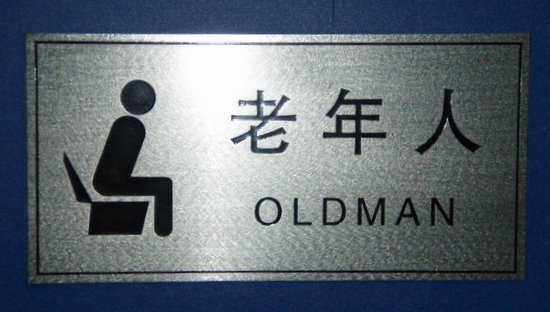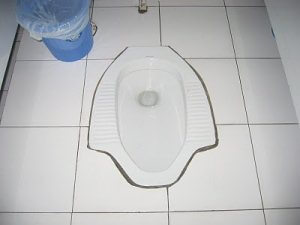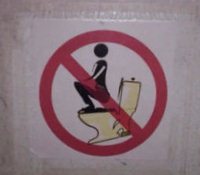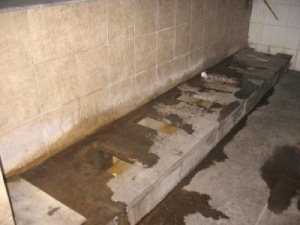Since the Olympics in 2008 Beijing’s public toilets are rapidly being updated, but if you’re planning on seeing more of the country then it’s worth being prepared for a change in standards.

Western Style Toilet in China
Styles of Toilet
There are 4 main styles of toilet in China. The most common in smaller cities and more rural hotels is the squat toilet. These are toilet cubicles stripped back to the bare minimum. Usually no more than a porcelain hole in the ground there is nowhere to hang your bag or coat, nothing to hold on to and rarely any toilet paper.

Chinese Squat Toilet
Used toilet paper should be placed in the basket provided. If there’s a bucket of water and a cup where the basket should be, this can be used in place of toilet tissue.
The old style flush is a pedal, but these are being replaced by automated flushes. Annoyingly these only seem to flush a few seconds after exiting the cubicle – exactly the time needed for the next impatient person to barge their way in and be horrified at what has just occurred.
The least common is the western style seated toilet. These are most likely found in Tier 1 cities, and then only in hotels, large shopping malls and international food chains, where they’re labelled as ‘Oldman Toilet’, or ‘Cripple Toilet’.

No Squatting sign
Common in private homes, seated toilets are considered unhygienic for public use as too many body parts might come into contact with the porcelain. A Chinese person forced to use these will often stand on the bowl and squat down, rather than sit, which usually renders it unusable for the next person. If there’s a basket, use it, but more modern buildings will allow flushing of paper.
The rest of the country has long-drop toilets. These can range from cubicles with large holes, to communal troughs, to a small hut on the edge of a cliff. The cubicles are the same as the standard squat toilet, without the need to flush. The problem here is the hole may only emptied once a week, so in the warm climate the smell can be noticeable, to say the least.
The small hut on the edge of a cliff, or worse a ‘designated area’ of flat ground are simple to use as long as your knees are up to it and often have a great view. Beware gusts of wind.

Communal Toilets
By far the worst to use are the communal toilets. These are holes or troughs with little or no privacy. No dividing walls and no doors. On the plus side, you don’t really touch anything so whilst they’re often dirtier than more organised toilets, if used carefully they can be considered more hygienic.
A few Do’s and Don’ts on usage
Firstly, just don’t. Do your best to avoid most public toilets by going at home. Thanks to Chinese food this may not be an option.
Do keep some small change on you. If there’s a charge there will usually be a little old lady sitting in the doorway. She may offer a single square of pink sandpaper. It’s better to bring your own tissues.
Don’t wear absorbent shoes. The floor is rarely clean.
Don’t take coats and bags in with you. There’s nowhere to put them.
As a general rule, your back should be toward the plumbing and you should be facing the door, if there is one. If there isn’t a door you’ll be facing the person squatting opposite you. They’ll probably intensely watch everything you do, so smile.
Try and keep your feet flat. This isn’t a time for losing your balance.
Do join in the conversation. There’s no taboo on chatting in Chinese toilets, so expect to answer a few questions.
Finally the most important one: No matter how urgent your needs may be, check your aim. Make sure you’re going to be on target and that your clothes are not on the ground, or in the line of fire.
The communal toilet photo was taken from the page of the very angry Rants about China.








I heard many things about the toilets in China, I have never been there myself but they do look like a challenge to use the first time 🙂 I would definitely have to get used to having people around me doing there thing without a wall between them.
Very low quality places like truck stops often don’t have any lighting, which can be a mixed blessing. You can’t be seen by other people, but you also can’t see where you’re walking…
Those communal toilets in China are really horrendous. Each visit was a challenge like no other. Something that’s hard to forget.
I also saw an open air communal toilet at a truck stop on the edge of the Gobi – the high winds made it an unforgettable experience for the chap at the end.
Pingback: What to Do in Beijing - Travel Tips for Beijing, China
Pingback: @_RobRob
Beijing Railway Station back in the 80s. Long trough with what should have been a flow of water from one end to the other. Backsides to the wall, no privacy, chatting between neighbours. On a good day the last man in line had everyone’s business flowing beneath him, but that day there was a water pressure problem and no flow. So each spot had a pyramid of various coloured deposits, and we had to hover with thighs and calves trembling, just above the summit of each pyramid. Lots of flies too.